Indoor houseplants are a fantastic way to add color and contrast to the living space. They are a joy to behold, and their green foliage provides the residents of a building with a sense of calmness and tranquility. Other than that, indoor houseplants also filter the air we breathe. However, people often wonder what indoor plants they should choose.
If you are also one of these people, consider purple indoor plants.
Even though not every purple plant has dark purple foliage from top to bottom, their green foliage combined with the purple hues still creates a calming, soothing effect and stunning display.
Some have blooms with vibrant amethyst-colored flowers, while others are dotted with violet spots or purple accent lines. Examples include Purple Oxalis, Purple Shamrock, Wandering Jew, and Purple Passion Plant.
You just cannot go wrong when you choose a purple house plant. So, please read on, and we will tell you everything there is to know about indoor purple plants.
RELATED: 8 Best Indoor Bonsai Trees To Turn A Corner Of Your Home Into A Magical Place
Popular Indoor Purple Plants
In the wild, purple or dark purple occur rarely, but the results are stunning when they do. When found with flowers and plants, it represents royalty and tradition. And in the world of symbolism, the color purple is often associated with admiration and success.
Purple plants also have individual religious, sentimental, and cultural values.
For example, the Chinese evergreen symbolizes good luck; the purple violet represents prayer in Christianity, and the purple lotus represents spirituality in Buddhist traditions.
Nevertheless, here is a comprehensive list of the most popular purple indoor plants.
1. Purple Shamrock (Oxalis triangularis)
Purple Shamrock is also known as triangularis due to its triangle-shaped deep purple leaves.
Overview
Purple Shamrock is a herbaceous ornamental indoor plant in the wood sorrel family and is native to South America. From a distance, it looks very different, with nearly black foliage. However, in reality, its foliage is an intense purple color. It has three heart-shaped purple leaves that resemble a trio of butterflies joined together by their noses.
Purple Shamrock Care Guide
| Aspect | Care Information for Purple Shamrock |
| Soil | Well-draining, nutrient-rich soil with a slightly acidic pH. |
| Light | Bright, indirect sunlight, or filtered light. Can tolerate some direct sunlight in the morning or evening. |
| Temperature & Humidity | Prefers temperatures between 60 to 75 °F (15 to 24 °C). Thrives in moderate humidity levels. Avoid drafts and sudden temperature changes. |
| Watering | Keep the soil evenly moist but not soggy. Allow the top inch of soil to dry out slightly between watering. |
| Feeding | Feed with a balanced fertilizer every 2 to 3 weeks during the growing |
| Propagation | Purple Shamrock is usually propagated through division or stem cuttings. |
| Toxicity | Moderately to severely toxic. If consumed in large amounts, it can cause severe kidney damage. |
Where To Buy?
Oxalis Triangularis (bulb/rhizome) | Wood sorrel, purple shamrock – Etsy
2. Ruby Necklace (Othonna capensis)
With its hanging leaves, Ruby Necklace is one of my favorite indoor purple plants.
Overview
Ruby Necklace is also known as String of Pickles or Little Pickles, and one look at this stunning purple succulent will reveal how the plant got its name. It is known for its pinkish-purplish hue and is surprisingly easy to grow and maintain. However, please note that its leaves will turn green in low light, and the plant will become leggy.
Ruby Necklace Care Guide
| Aspect | Care Information for Ruby Necklace (Othonna capensis) |
| Soil | Well-draining, slightly acidic to neutral soil (pH range of 6.0 to 7.0.) Sandy or loamy soil is the best. |
| Light | Full sun to partial shade. Needs at least 4 to 6 hours of direct sunlight per day. |
| Temperature & Humidity | Prefers temperatures between 60 to 80 °F (15 to 27 °C). Thrives in low to moderate humidity levels. Avoid frost and high temperatures above 90 °F (32 °C). |
| Watering | Allow the soil to dry out completely between watering. Water thoroughly but infrequently to prevent root rot. Reduce watering during the winter. |
| Feeding | Fertilize with a balanced fertilizer every 2 to 3 weeks in the growing season. |
| Toxicity | Not toxic if ingested. But, it may cause skin irritation in some individuals. |
Where To Buy?
Ruby\’s necklace Live Plant Othonna Capensis – Etsy

3. Pink Quill (Wallisia cyanea)
Pink quill has delicate dark pink or purple flowers that bloom in spring and autumn.
Overview
Pink Quill gets its name from the plume of purple and pink bracts that last for months, and it belongs to the bromeliad family of air plants. However, it is vital to note that the plant takes a few years to mature and will not flower until then. Nevertheless, it is still a very cool plant to own. Why? Because it is an epiphyte, it does not need any soil to grow and will attach itself to the bark of trees using its roots.
Pink Quill Care Guide
| Aspect | Care Information for Pink Quill (Wallisia cyanea) |
| Soil | Well-draining soil rich in organic matter. Use a potting mix with peat moss or coco coir, perlite, and vermiculite. |
| Light | Bright, indirect sunlight, or filtered light. Avoid direct sunlight, as it can burn the leaves. |
| Temperature & Humidity | Prefers temperatures between 60 to 75 °F (15 to 24 °C). Thrives in moderate to high humidity levels. Avoid drafts and sudden temperature changes. |
| Watering | Keep the soil evenly moist but not soggy. Water the center of the plant (where the quill is located) and not the leaves. |
| Feeding | Fertilize with a balanced fertilizer every 2-3 weeks during the growing season. Avoid fertilizing during the winter months. |
| Toxicity | Pink Quill is not considered toxic. |
Where To Buy?
Purple flower pineapple Tillandsia cyanea seeds – Etsy
4. Purple Waffle Plant (Hemigraphis Alternata)

The purple waffle plant is a delightful small indoor houseplant native to the Maluku Islands of Indonesia.
Overview
The purple waffle plant is an excellent indoor plant known for its outstanding air-purifying properties. Furthermore, despite its diminutive stature, its distinctive purple foliage makes it stand out. And it is often used as an annual garden or container plant in cooler climates. You can also use purple waffle plants as a ground cover underneath taller indoor plants.
Purple Waffle Plant Care Guide
| Aspect | Care Information for Purple Waffle Plant |
| Soil | Well-draining, acidic soil mix with high organic matter content |
| Light | Bright, indirect light; avoid direct sunlight |
| Temperature & Humidity | Ideally kept in a temperature range of 18 to 27 °C (65 to 80 °F) Prefers moderate to high humidity levels |
| Watering | Water thoroughly when the top inch of soil feels dry to the touch Avoid overwatering or allowing the soil to dry out completely |
| Feeding | Fertilize every two weeks during the growing season (spring and summer). Always use a balanced liquid fertilizer |
| Toxicity | Purple Waffle Plant is toxic to pets and humans if ingested. |
Where To Buy?
Hemiographis Colorata/Purple Waffle Plant 1x Bunch – Amazon
RELATED: 25 Beautiful And Easy To Grow Purple Succulents For Homes & Offices
5. Purple Ti Plant (Cordyline fruticosa)
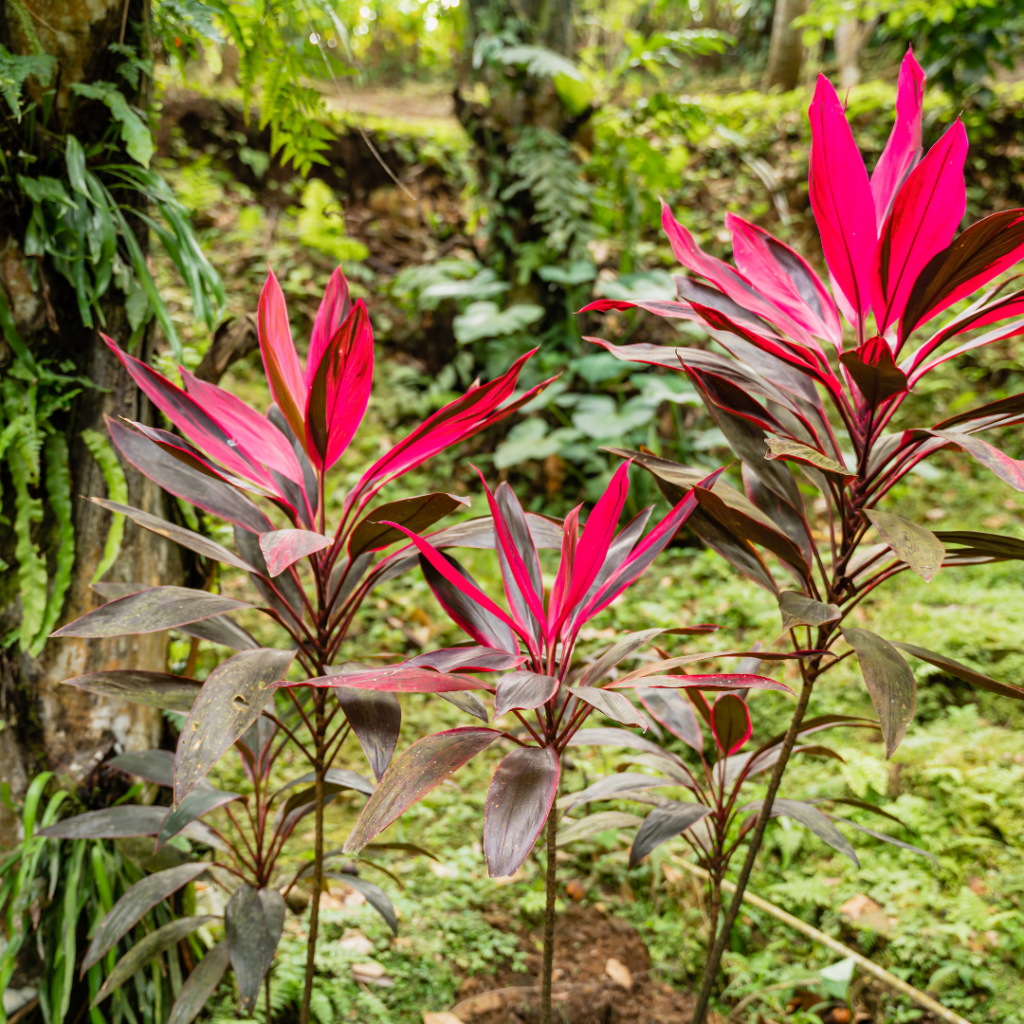
Ti plants have purple foliage variegated with stripes of white, cream, pink, or other shades of purple.
Overview
Ti plant is a tropical broadleaf evergreen plant with purple palm-like leaves. Also known as cabbage palm, or good luck plant, the Ti plant is an attractive choice for adding style, contrast, and drama to any indoor space of your home. Even nowadays, Ti plants\’ leaves are used in rituals to celebrate the god Lono and the goddess Laka in native Hawaii.
Purple Ti Plant Care Guide
| Aspect | Care Information for Ti Plant (Cordyline fruticosa) |
| Soil | Well-draining soil with high organic matter content. Thrive well in pH between 6.0 and 6.5. |
| Light | Prefer bright, indirect light; can tolerate some direct sunlight but not full sun |
| Temperature & Humidity | Ideally, it should be kept at 18 to 24 °C (65 to 75 °F). For best results, place in moderate to high humidity levels. Avoid exposure to temperatures below ten °C (50 °F). |
| Watering | Water thoroughly when the top inch of the soil feels dry to the touch. However, reduce watering in winter. |
| Feeding | Fertilize every two weeks during the growing season. Always use a well-balanced liquid fertilizer. |
| Toxicity | If ingested, Ti Plant is toxic to pets and humans; it can cause skin irritation. |
Where To Buy?
FRESH FROM HAWAII Ti Plant Cutting – Etsy
6. Gloxinia (Sinningia speciosa)
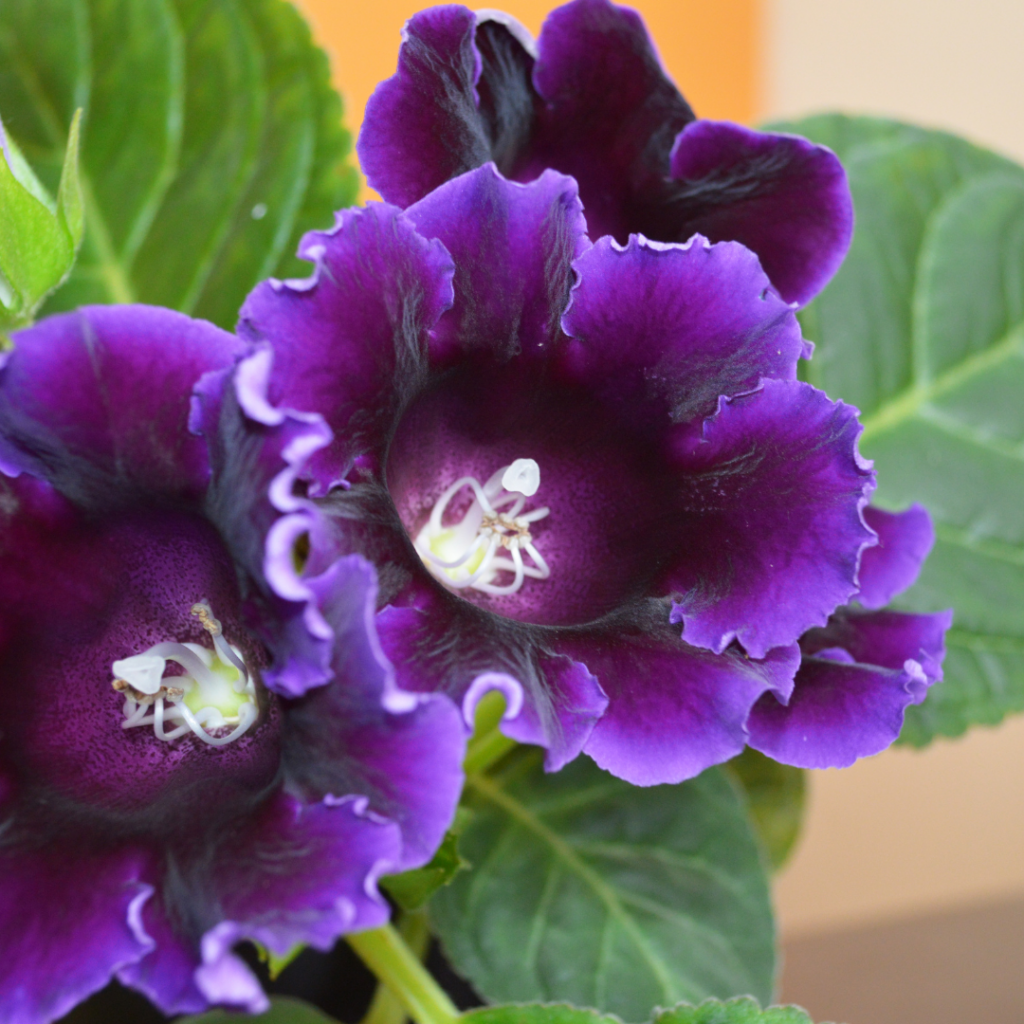
Gloxinias have fuzzy leaves and grow large, vibrant flowers, usually red and purple.
Overview
Gloxinia plants can be an excellent addition to any home or garden. They have ovate velvety green leaves that form a basal rosette. Moreover, they aren\’t very high-maintenance plants; even if you are new to indoor gardening, you can easily care for them.
Gloxinias bloom in summer and produce large, bell-shaped pink or purple flowers. However, it is vital to note that you will lose this plant after its blooming period expires.
Gloxinia Care Guide
| Aspect | Care Information for Gloxinia (Sinningia speciosa) |
| Soil | Well-draining, loose soil mix with high organic matter content For best results, adjust soil pH between 5.5 and 6.5 |
| Light | Bright, indirect light; avoid direct sunlight |
| Temperature & Humidity | Ideally kept in a temperature range of 18to 24 °C (65to 75 °F) Prefers moderate humidity levels Avoid exposing to temperatures below 13 °C (55 °F) |
| Watering | Water thoroughly when the top inch of the soil feels dry to the touch. Reduce watering in winter. |
| Feeding | Fertilize every two weeks during spring and summer. Fertilize with a balanced liquid fertilizer. Reduce or stop feeding in fall and winter |
| Toxicity | Gloxinia is toxic to pets and humans if ingested. |
Where To Buy?
Gloxinia (Purple – White) – Plant – Plant&Jungle
7. Purple Passion (Gynura Aurantiaca)
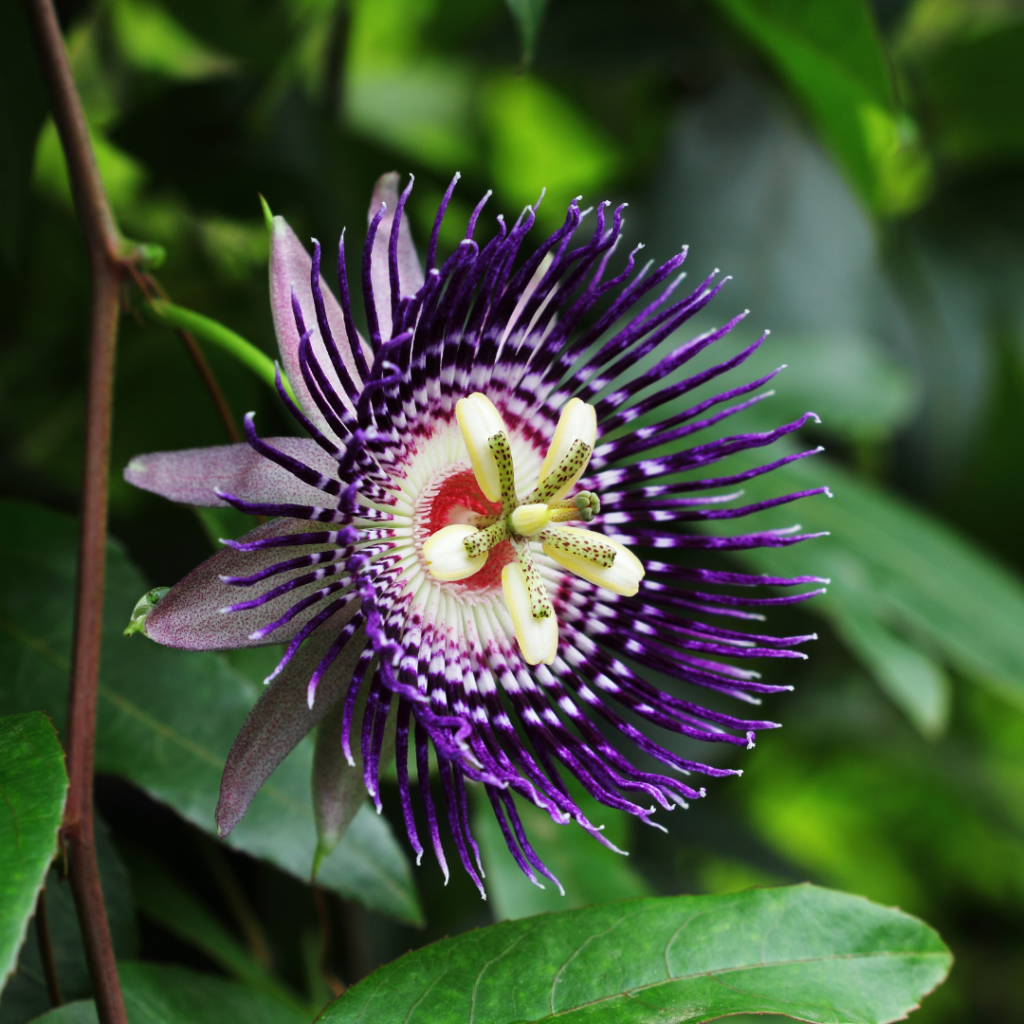
Purple passion is a unique indoor houseplant with gorgeous fuzzy purple and green leaves.
Overview
Growing purple passion offers an unforgettable and attractive indoor houseplant for the brightly residential or office area. These unique plants are immediately identifiable by their serrated leaves, covered in dense violet hair and purple leaf edges. When young, these plants have an upright habit but become almost vine-like as it matures.
Furthermore, unlike many indoor plants that take a few years to reach their most attractive stage, these plants flaunt their brightest colors in the first two to three years.
Purple Passio Care Guide
| Aspect | Care Information for Purple Passion (Gynura Aurantiaca) |
| Soil | Well-draining soil with high organic matter content; pH between 5.5 and 6.5 |
| Light | Bright, indirect light; can tolerate some direct sunlight but not full sun |
| Temperature & Humidity | Ideally kept in a temperature range of 18to 24 °C (65 to 75 °F), with moderate to high humidity levels |
| Watering | Water thoroughly when the top inch of soil feels dry to the touch |
| Feeding | Fertilize every two weeks during the growing season (spring and summer) with balanced liquid fertilizer; reduce or stop feeding in fall and winter |
| Toxicity | Purple passion is non-toxic to pets and humans |
Where To Buy?
Purple passion plants rare houseplants Gynura aurantiaca – Etsy
8. Persian Shield Plant (Strobilanthes dyerianus)

Persian shield is a warm-zone evergreen shrub native to Myanmar—formerly Burma.
Overview
Chances are pretty good that you have seen a Persian Shield Plant with its attractive purple foliage plant at nursery centers. The main attraction of this plant is its deep purple iridescent leaves with dark green veins and serrated edges. You can even create a striking contrast by pairing the Persian shield plant with orange or yellow indoor plants. Persian Shield Plant is hardy in USDA zones 8 to 11 but is more commonly grown indoors.
Persian Shield Plant Care Guide
| Aspect | Care Information for Persian Shield Plant (Strobilanthes dyerianus) |
| Soil | Prefers well-draining soil rich in organic matter. A mixture of peat moss, perlite, and vermiculite is recommended. The soil pH level should be between 5.5 and 6.5. |
| Light | Requires bright, indirect light to grow and thrive. They do not tolerate direct sunlight, which can scorch the leaves. |
| Temperature & Humidity | Prefers warm temperatures between 60 °F to 85 °F (15 °C to 30 °C).Keep the plant away from cold drafts or sudden temperature changes. |
| Watering | Needs even moisture in the soil, but do not overwater. Use room temperature water. Reduce watering when growth slows down. |
| Feeding | Benefit from regular feeding with a balanced, water-soluble fertilizer. Feed every 2 to 4 weeks during the growing season |
| Toxicity | Non-toxic |
Where to Buy?
Persian Shield Plant-Strobilanthes dyeriana- Royal Purple Plant- Etsy
9. Purple Coleus (Plectranthus scutellarioides)
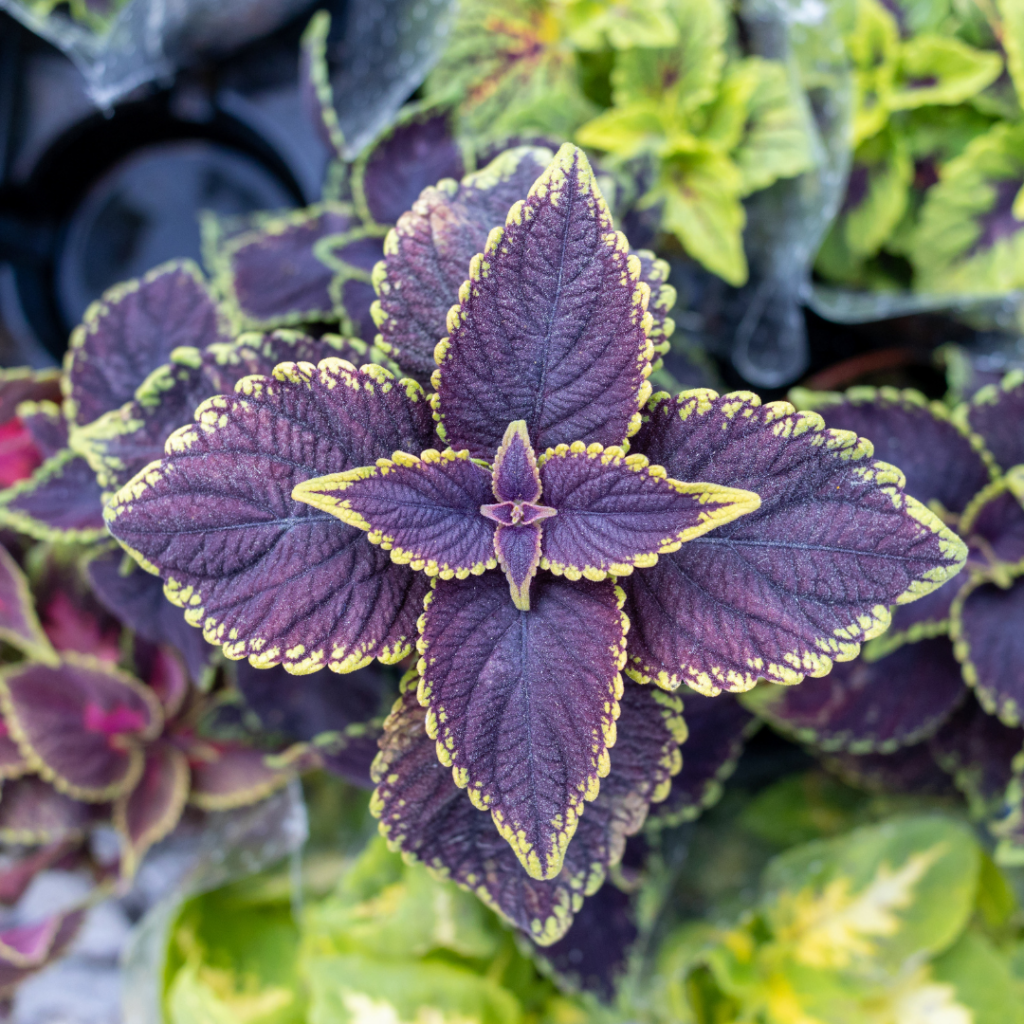
Coleus is a tropical plant with striking purple and green foliage, often grown annually.
Overview
Purple coleus is a beautiful, low-maintenance indoor plant known for its colorful multi-colored foliage that will add a sense of royalty and calmness to any indoor living space. Purple Coleus plants are easy-to-grow plants for both indoor and outdoor gardens. Their vividly colored foliage adds a decorative touch to hanging baskets, indoor container gardens, and window boxes. All in all, It is a tolerant plant for the casual indoor gardener.
Purple Coleus Care Guide
| Growing Factor | Optimal Growing Conditions for Coleus Plant |
| Soil, | Prefers well-draining soil rich in organic matter. A mixture of peat moss, perlite, and vermiculite is best. The soil pH should be between 6.0 and 7.5. |
| Light | Requires bright, indirect light to grow and thrive. Some varieties can tolerate full sun. But avoid low-light conditions. |
| Temperature & Humidity | Prefers warm temperatures between 70 °F to 100 °F (21 °C to 38 °C). High humidity is preferred, but they can tolerate low humidity. |
| Watering | Needs consistently moist soil but does not allow the ground to become waterlogged. Use room temperature water when rinsing. |
| Feeding | Feed every 2 to 4 weeks during the growing season. Do not fertilize during the winter months. |
| Toxicity | Coleus plants are generally non-toxic. Some varieties, however, cause skin irritation or allergic reactions in sensitive individuals. |
Where To Buy?
Coleus seeds Special Purple (20 Per Pack) – Etsy
10. Purple Vanda Orchid (Vanda sanderiana)
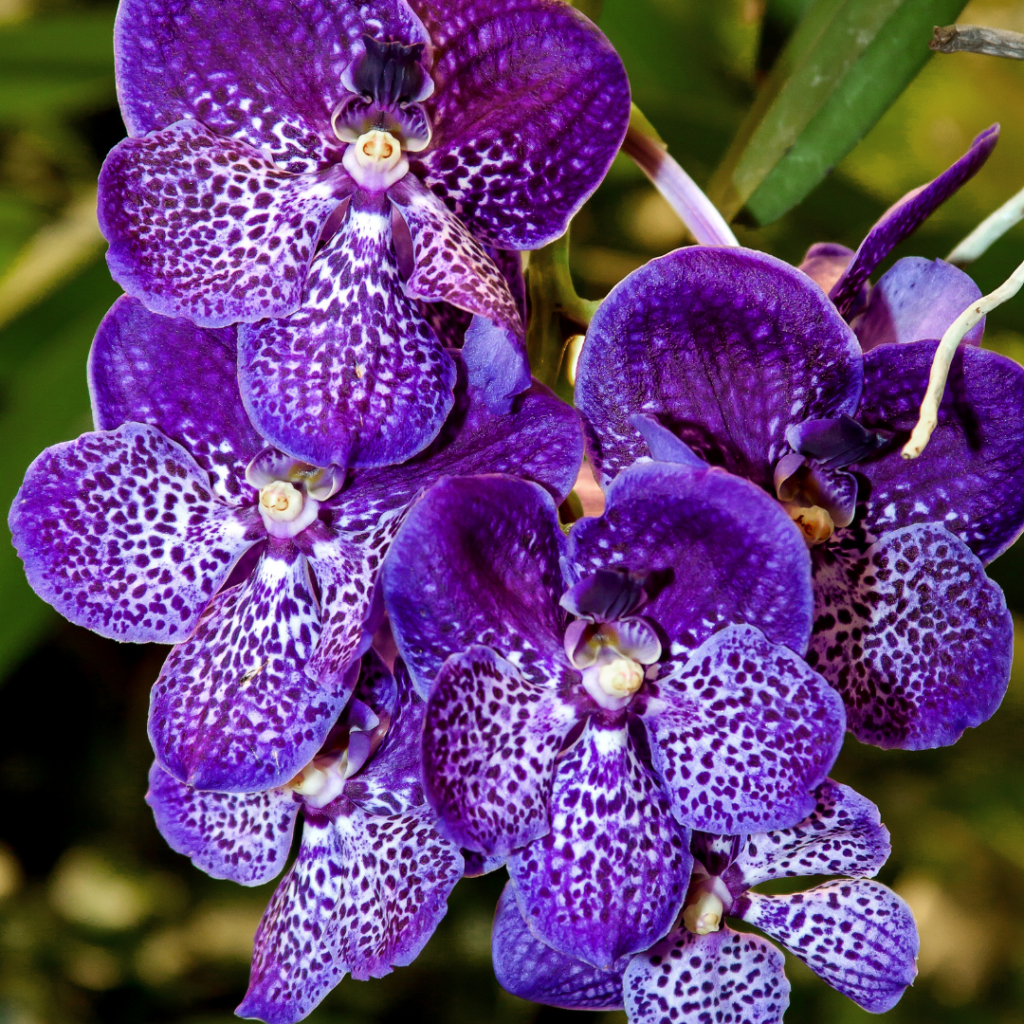
Coveted worldwide, Vanda is a genus of 50 orchid species scattered throughout tropical Asia.
Overview
Thinking of growing vanda orchids but unsure where to start? A great choice would be to plant the elegant purple vanda orchid. These orchids are fragrant and best known for producing bluish-purple flowers. Furthermore, caring for Purple Vanda Orchids is simple, given you remember a few critical things related to their preferences. For example, these purple orchids must be kept from hot sunshine to avoid sun scorching on the leaves.
Purple Vanda Orchid Care Guide
| Growing Factor | Optimal Conditions for Purple Vanda Orchid |
| Soil | Grow in a well-draining orchid mix with sphagnum moss, bark, and perlite. |
| Light | Requires bright, indirect light to grow and bloom. Avoid direct sunlight and provide 4 to 6 hours of bright sunshine daily. |
| Temperature & Humidity | Prefers warm temperatures between 70 °F to 95 °F (21 °C to 35 °C). Thrive in humidity levels between 50% to 80%. Also, need good air circulation to prevent fungal and bacterial diseases. |
| Watering | Needs frequent watering, as often as daily, to keep the roots moist. Do not let the roots sit in standing water. Reduce watering when growth is slow. |
| Feeding | Feed every two weeks during the growing season. |
| Toxicity | It may cause gastrointestinal upset if ingested. |
Where To Buy?
Orchid Vanda Pachara Delight Pachara Tropical Hanging Plant – Etsy
11. Purple Cyclamen (Cyclamen purpurascens)
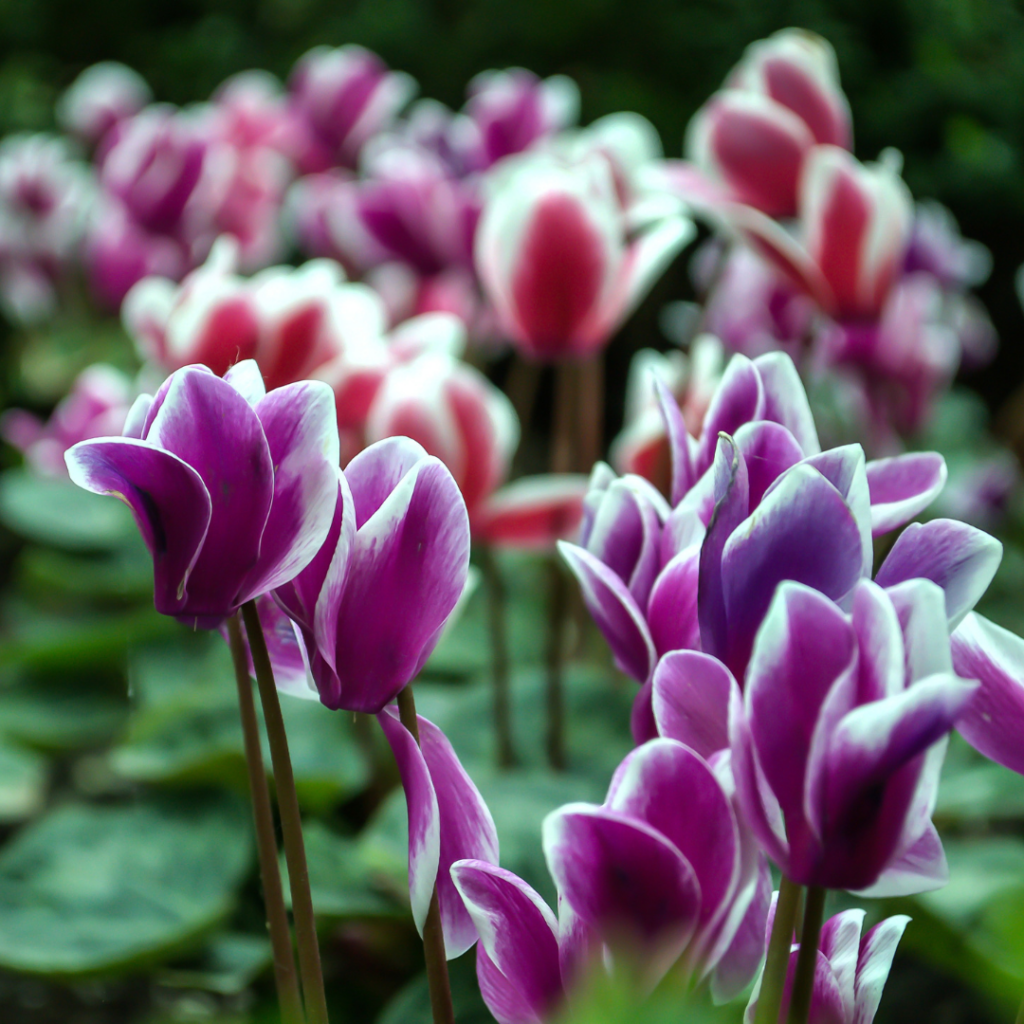
Cyclamen is known for its large green leaves and pink and purple flowers with a sweet primrose fragrance.
Overview
Purple cyclamens look complicated but are easier to care for than you might think. Their vibrant flowers and exhilarating leaves make this plant a popular houseplant. It produces colorful blooms continuously for a couple of months, every fall and winter. Furthermore, due to new cultivars, purple cyclamen blooms are larger, more vibrant, and more dazzling than ever. Also, when done blooming, you can compost these purple plants.
Purple Cyclamen Care Guide
| Growing Factor | Optimal Conditions for Purple Cyclamen |
| Soil | Soil pH should be between 6.0 and 7.0.A mixture of peat moss, perlite, and sand is recommended. |
| Light | Avoid direct sunlight, which can scorch the leaves. Provide indirect 4 to 6 hours of bright sunshine per day. |
| Temperature & Humidity | Need cool temperatures between 50 °F to 60 °F (10 °C to 16 °C). Also, they require high humidity levels between 50% to 60%. |
| Watering | Needs consistently moist soil, but avoid overwatering. Do not water the plant\’s crown, as this can cause rot. |
| Feeding | Benefit from occasional feeding with a balanced, water-soluble fertilizer. Feed every 4 to 6 weeks during the growing season. |
| Toxicity | Keep out of reach of children and pets. It can cause gastrointestinal upset when ingested or skin irritation on contact. |
Where To Buy?
30 seeds of PURPLE CYCLAMEN flowers – Etsy
12. Purple Calathea (Calathea Makoyana)

It has thin foliage that grows in beautiful purple and deep green hues with lime-green patterns.
Overview
It\’s hard to look away once you set your eyes on Purple Calathea since it can change color depending on the viewing angle and lighting conditions. Purple Calatheas are also sometimes known as peacock or zebra plants because of the plants\’ eye-catching stripes and veining. All in all, they make great indoor plants, and you can place them in the kitchen, bathroom, or any area with extra moisture in the air and indirect sunlight.
Purple Calathea Care Guide
| Growing Factor | Optimal Conditions for Purple Calathea |
| Soil | Prefers well-draining soil rich in organic matter. |
| Light | Requires bright, indirect light to grow and thrive. They do not tolerate direct sunlight. Also, avoid low light conditions. |
| Temperature & Humidity | Thrive in warm temperatures between 65 °F to 80 °F (18 °C to 27 °C). Need high humidity levels between 50% to 80%. |
| Watering | Avoid overwatering or allowing the soil to become waterlogged. Water when the top inch of soil feels dry to the touch. Use room temperature water. Reduce watering during the winter months. |
| Feeding | Benefit from regular feeding with a balanced, water-soluble fertilizer. Feed every 2 to 4 weeks during the growing season. Do not fertilize during the winter months. |
| Toxicity | Calathea plants are non-toxic to humans and pets. |
Where To Buy?
Large Calathea Medallion Shine Star – Etsy
RELATED: 65 Stunning Purple Flowers of Different Types (Including Pictures)
13. Wandering Jew (Tradescantia zebrina)
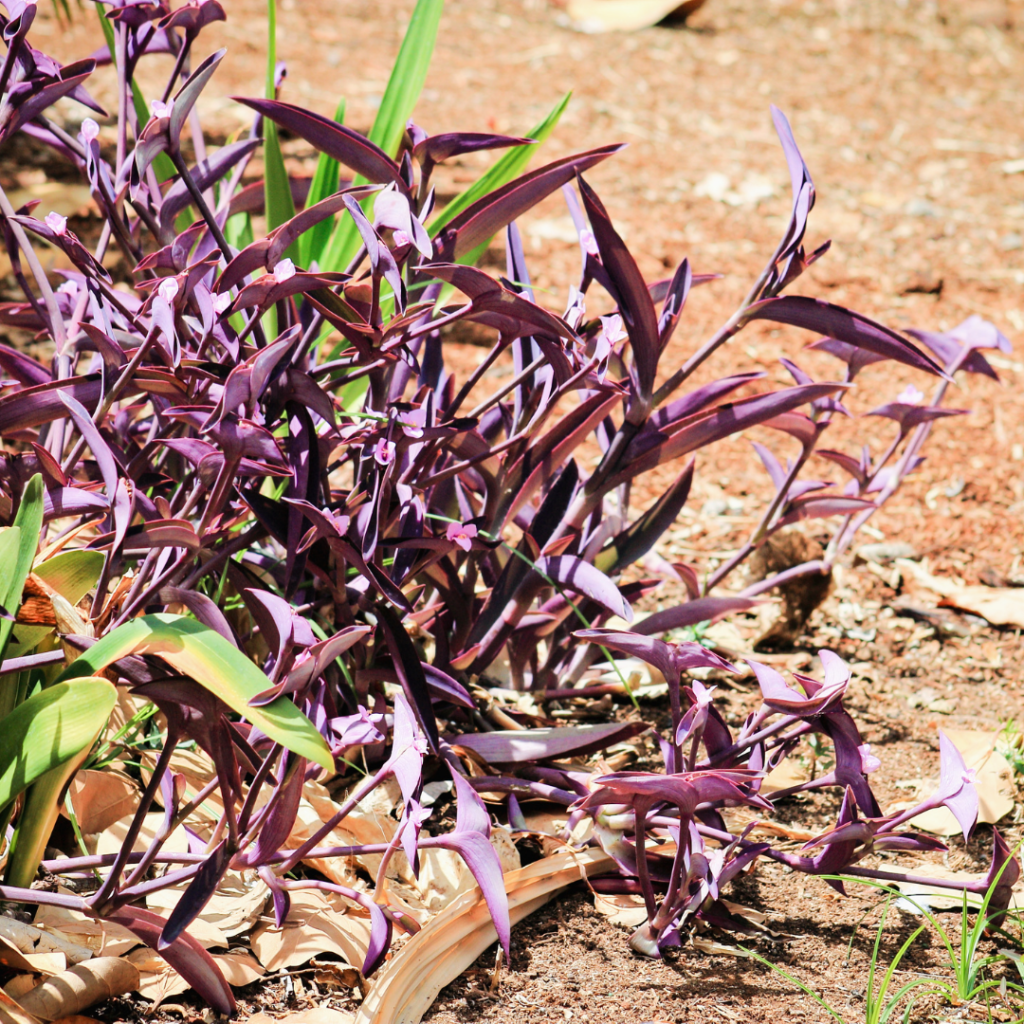
Wandering Jew is a fast-growing, easy-to-care-for purple indoor plant.
Overview
Wandering Jew is a beginner-friendly houseplant that is low-maintenance and grows quickly. It has many growing characteristics that make it perfect as an indoor vining plant. For example, it can thrive in low-light and high-humidity conditions. Nevertheless, these plants are loved for their unique bright colors and vining growth habits. Indoors, you can place them in a hanging basket to show off their trailing vines or in a pot. Whatever you like!
Wandering Jew Care Guide
| Growing Factor | Optimal Conditions for Wandering Jew |
| Soil | Prefers well-draining soil rich in organic matter. A mixture of peat moss, perlite, and vermiculite is recommended. The soil pH level should be between 6.0 and 7.0. |
| Light | Requires bright, indirect light to grow and thrive. They can tolerate some direct sunlight, but too much can scorch the leaves. Avoid low light conditions, which can cause the plant to become leggy. |
| Temperature & Humidity | Require warm temperatures between 65 °F to 75 °F (18 °C to 24 °C). They require moderate humidity levels between 40% to 60%. |
| Watering | Needs consistently moist soil, but avoid overwatering. Reduce watering during the winter months or when growth slows down. |
| Feeding | Benefits from occasional feeding with a balanced, water-soluble fertilizer. Do not fertilize during the winter months. |
| Toxicity | Toxic if ingested and can cause gastrointestinal upset or skin irritation. Keep out of reach of children and pets. |
Where To Buy?
2 Rare Wandering Jew Burgundy CUTTINGS – Etsy
14. Rex Begonia (Begonia rex-cultorum)
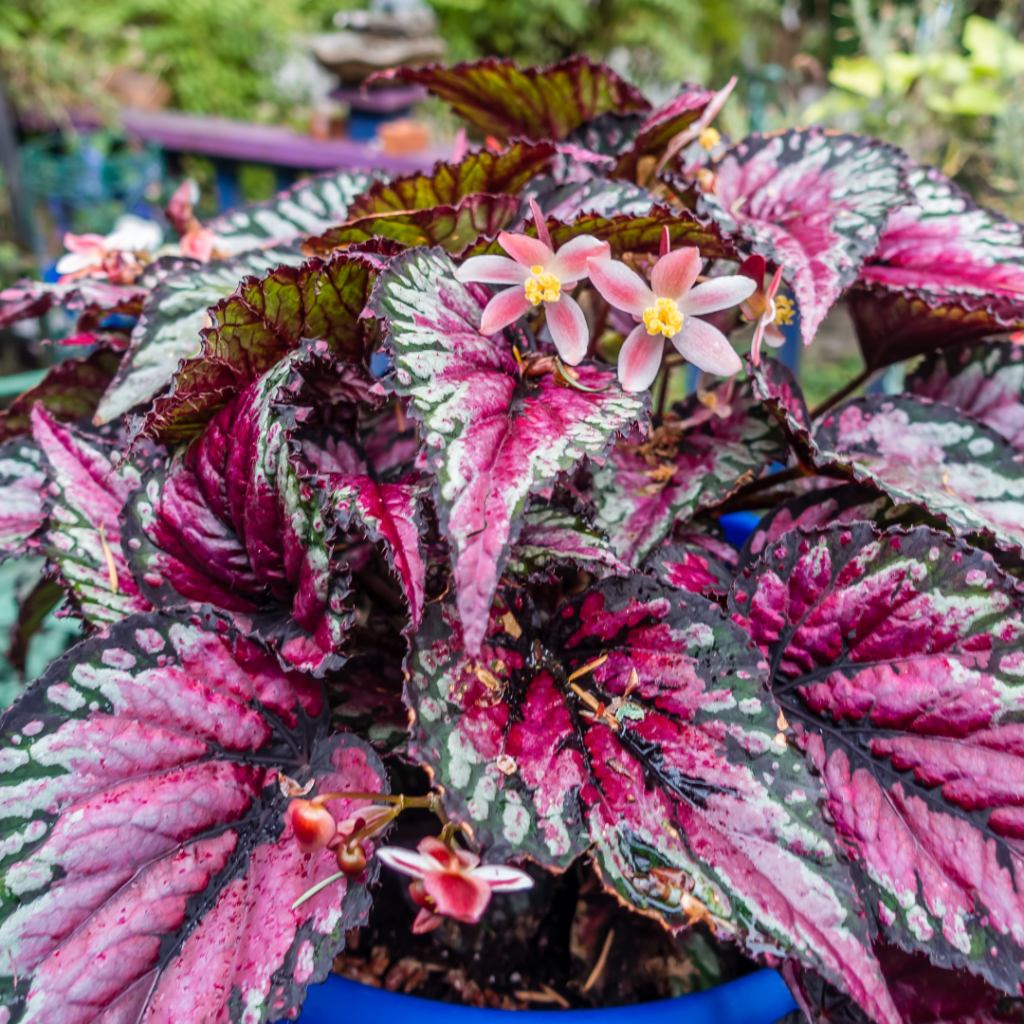
Rex Begonia is good-natured – it is as easy to care for as they are easy on the eyes.
Overview
Begonia rex is one of the most beautiful and dramatic plants among various Begonias. Its leaves can vary in form – from ivy-like forms to hearts, seashell swirls, and more. However, their main attraction is the beautiful and ornate foliage that it produces. When growing these plants, do not let the flowers grow and bloom. They use all of the plant\’s energy and make their purple leaves look dull. So, pinch them off as soon as you see them.
Rex Begonia Care Guide
| Growing Factor | Optimal Conditions for Rex Begonia |
| Soil | Use well-draining soil rich in organic matter. Keep the soil pH slightly acidic pH between 5.5 and 6.5. |
| Light | Provide bright, indirect light, and avoid exposing the plant to direct sunlight. |
| Temperature & Humidity | Keep the plant in moderate temperatures between 60 °F to 75 °F (16 °C to 24 °C). Avoid exposing it to cold drafts or sudden temperature changes. |
| Watering | Keep the soil consistently moist but avoid overwatering. Water when the top inch of soil feels dry to the touch. |
| Feeding | Use a balanced, water-soluble fertilizer every 2 to 4 weeks. Feed in the growing season, but avoid fertilizing during the winter. |
| Toxicity | Rex Begonia is safe for humans and pets. |
Where To Buy?
10 Seeds Begonia Purple Colorplants Big Begonia – Etsy
15. Purple Prayer Plant (Maranta leuconeura)
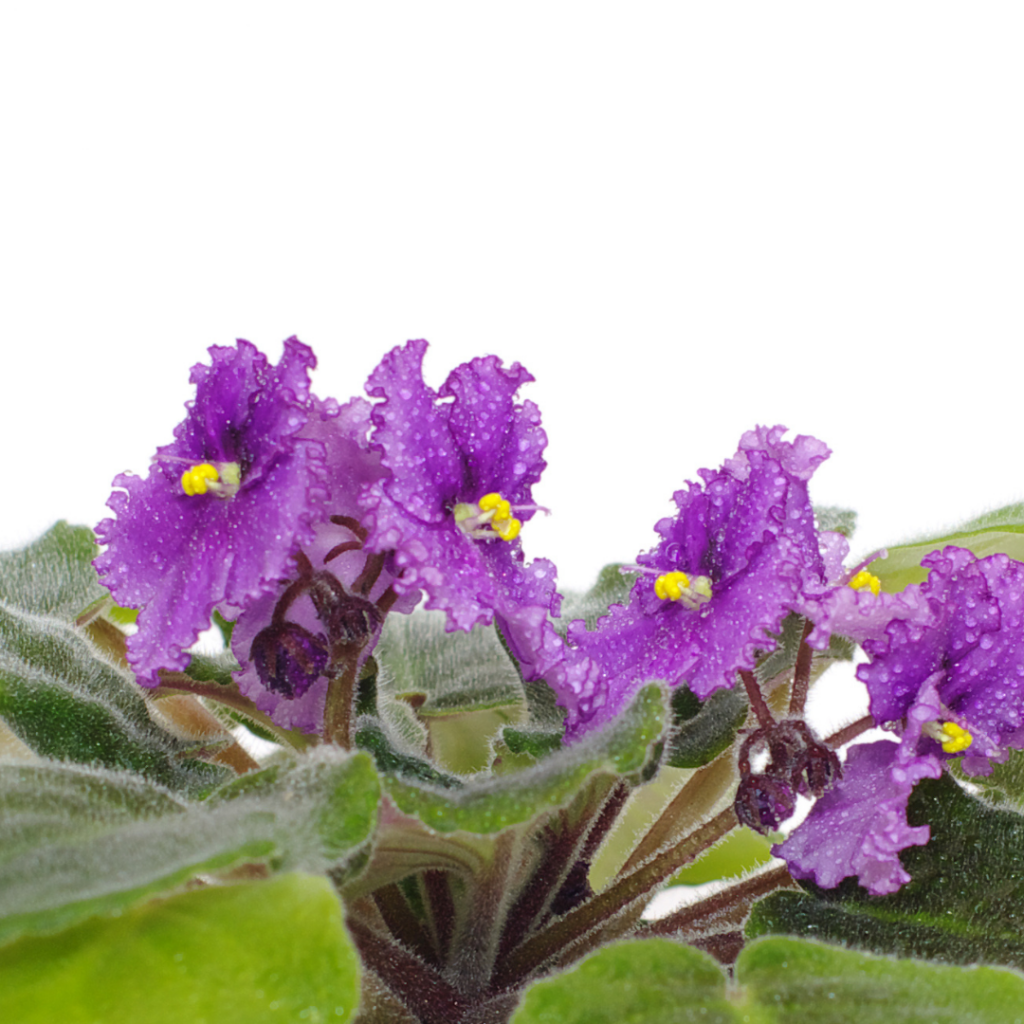
Prayer plant flowers in small white to purple blooms that grow in pairs on a single inflorescence.
Overview
One of the most exciting houseplants out there is the prayer plant. They aren’t as easy to keep, but their patterned, purple foliage makes them worth the extra effort. A slow-grower, the prayer plant can eventually reach up to a foot in height indoors. The leaves of the prayer-plants move. At dusk, the leaves fold together as if in prayer. And, then, open at dawn. And, if you grow prayer plants or would like to, read the care guide below.
Purple Prayer Plant Care Guide
| Growing Factor | Optimal Conditions for Prayer Plant |
| Soil | Use well-draining soil rich in organic matter. Adjust the soil pH to a slightly acidic pH between 5.5 and 6.5. |
| Light | Provide bright, indirect light, and avoid exposing the plant to direct sunlight. |
| Temperature & Humidity | Keep the plant in moderate temperatures between 65°F to 75°F (18°C to 24°C). Keep high humidity levels between 50% to 60%. Avoid exposing it to cold drafts or sudden temperature changes. |
| Watering | Keep the soil consistently moist but avoid waterlogging the ground. Water when the top inch of soil feels dry to the touch; use room temperature water. |
| Feeding | Use a balanced, water-soluble fertilizer every 2 to 4 weeks. Avoid fertilizing during the winter months. |
| Toxicity | Prayer Plant is non-toxic and safe for humans and pets. |
Where To Buy?
Crochet Prayer Plant, Silver Band Crochet Plant – Etsy
16. Moses in the Cradle (Tradescantia spathacea)
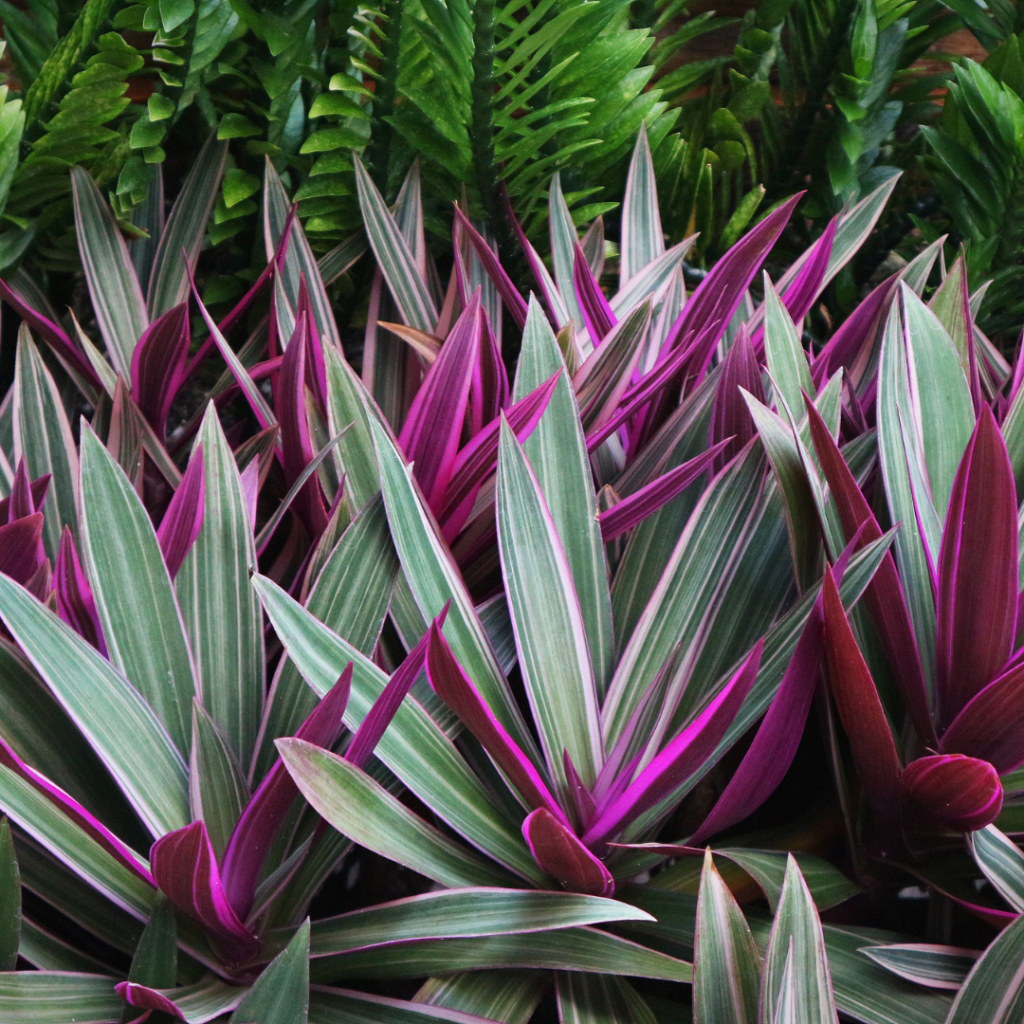
Moses In The Cradle produces rosette leaves that are green on top and a rich purple on the underside.
Overview
Moses in the Cradle has been a much-loved houseplant for centuries. The types sold as indoor plants are typically \”small\” and only reach a height of about six or twelve inches. It is an attractive houseplant throughout the year, thanks to its lance-shaped leaves with purple-red undersides. You may have heard the Moses plant called by alternative names such as Oyster plant, Moses-in-a-Basket, Cradle Lily, Boat Lily, and Moses-in-a-Boat.
Moses in the Cradle Care Guide
| Growing Factor | Optimal Conditions for Moses in the Cradle |
| Soil | Grows best in light soil with good drainage. You can also use good-quality, all-purpose potting soil. |
| Light | Needs very bright light for at least 6-8 hours daily. In low light conditions, the plant will become leggy. However, avoid placing the plant in direct sunlight. |
| Temperature & Humidity | 60 to 85 degrees F (16 to 19 C) optimizes growth. Keep the humidity at about 70 percent for the best development. |
| Watering | Keep the soil consistently moist. Water when the top one inch is dry. Do not overwater. Use room temperature water. |
| Feeding | Use a balanced fertilizer every ten months for colder regions with less sunlight. Use a balanced fertilizer once every six months for warmer areas |
| Toxicity | Poisonous house plants with a #3 toxicity level. It can cause contact dermatitis when in contact with bare skin. |
Where To Buy?
4\” Oyster Plant – Tradescantia Spathacea – LIVE PLANT – Etsy
17. African Violet (Streptocarpus sect. Saintpaulia)
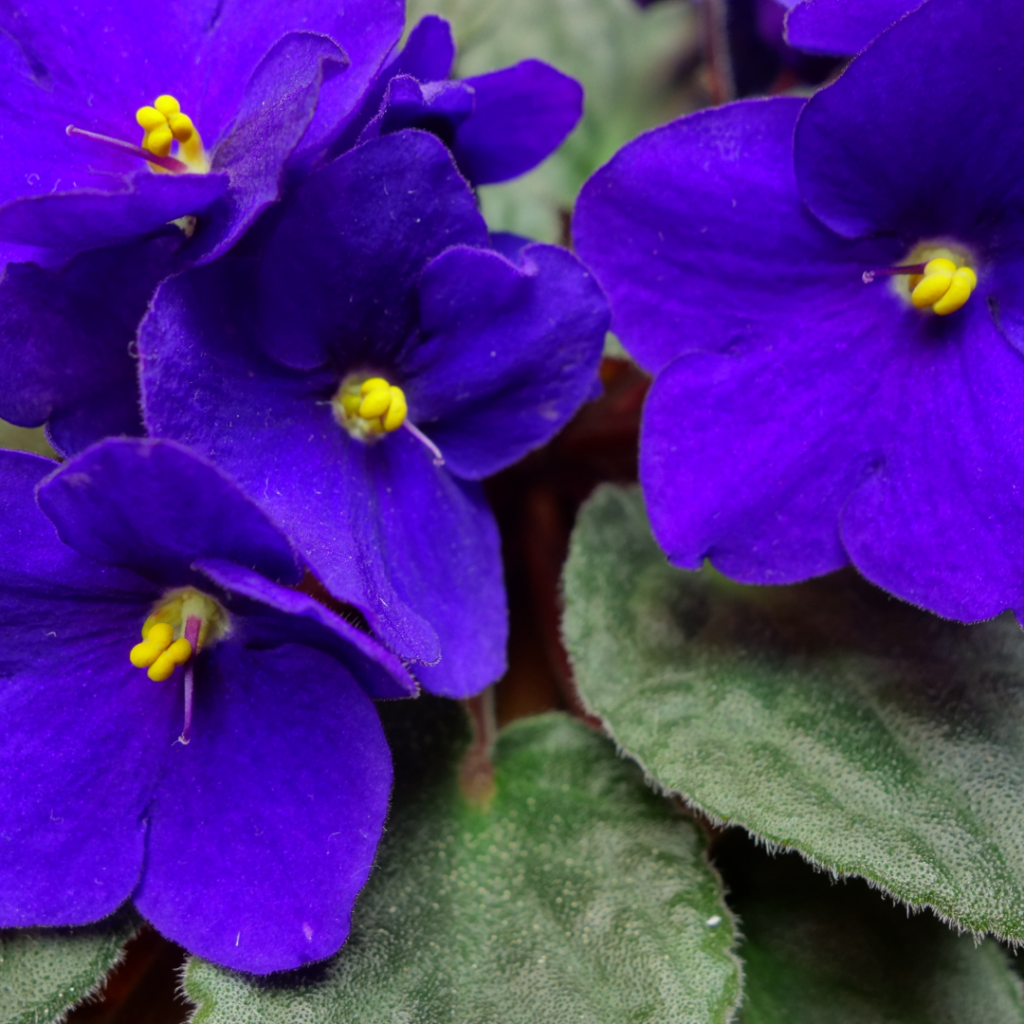
For a good reason, African violets is one of the world\’s most popular indoor houseplants.
Overview
Despite their common name, African violets are not a type of violet. But that does not matter. What matters is that they produce bright purple blooms that will brighten up any indoor living space. Moreover, these compact, low-growing plants flower several times a year, and they can be purchased in many colors and forms other than purple. Only a few other indoor houseplants can match their ability to thrive and bloom indoors for months.
African Violet Care Guide
| Care Factor | Requirement for African Violet |
| Soil | Well-draining soil with a pH between 5.5-6.5. For example, a mix of peat moss, perlite, and vermiculite. |
| Light | Place in indirect bright light, ideally 12 to 16 hours of sunshine daily. Avoid direct sunlight as it can scorch the leaves. |
| Temperature & Humidity | Place indoors between 65 to 75 °F (18 to 24 °C). Keep the humidity levels around 50 to 60 percent. Avoid cold drafts and sudden temperature changes. |
| Watering | Keep soil moist but not waterlogged. Water when the top inch of soil feels dry. Avoid getting water on the leaves to prevent spotting. |
| Feeding | Fertilize with a balanced liquid fertilizer every 2 to 3 weeks. Fertilize during the growing season (spring and summer). And reduce feeding during the winter. |
| Toxicity | African Violets are non-toxic to humans and pets. |
Where To Buy?
10 Zebra stripped African Violet flower seeds – Etsy
18. Iron Cross Houseplant (Oxalis tetraphylla)
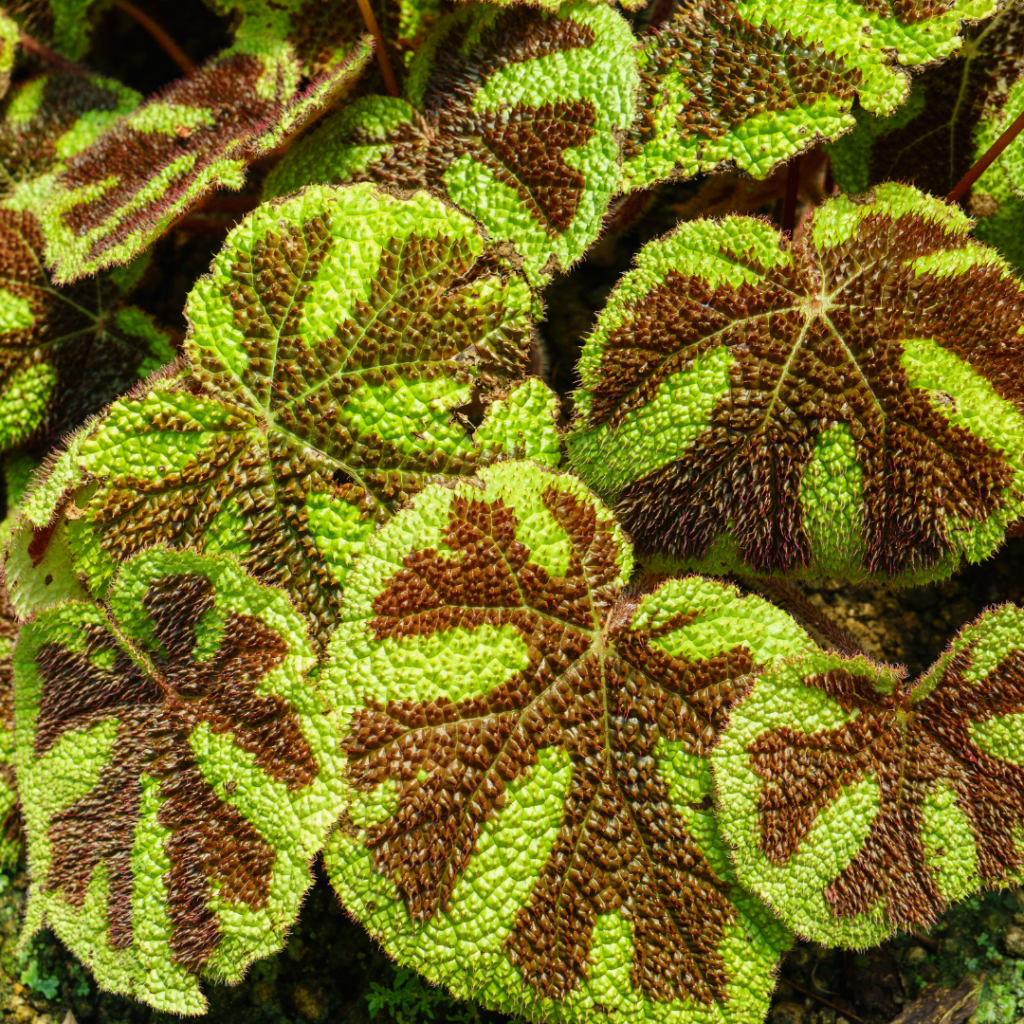
Iron Cross is a relatively rare houseplant with green with striking purple patterns.
Overview
Oxalis plants are known and loved for their unique, delightful blossoms, and the iron cross is no different. It has bright green puckered leaves marked with a reddish-brown iron-cross pattern in the center. The tiny hairs that grow all over its stems and foliage make the iron cross plant extra special. They can often bloom all winter if kept in a sunny spot. However, if you want their attractive foliage, do not let the flowers bloom to maturity.
Iron Cross Houseplant Care Guide
| Factor | Requirement for Iron Cross Houseplant |
| Soil | Plant in well-draining soil with a neutral pH. Use a good mix of potting soil, sand, and perlite. |
| Light | Place in bright indirect light, preferably 4 to 6 hours of direct sunlight daily. Avoid prolonged exposure to direct sunlight as it can scorch the leaves. |
| Temperature & Humidity | They prefer indoor temperatures between 60 to 75 °F (15 to 24 °C). Place in moderate humidity levels of around 40 to 60 percent. Avoid exposing the plant to cold drafts. |
| Watering | Water thoroughly, but allow the soil to dry out slightly between waterings. Do not let the ground become waterlogged, as this can lead to root rot. |
| Feeding | Fertilize every 2 to 4 weeks during the growing season. Always use a balanced liquid fertilizer. Reduce feeding during the winter. |
Where To Buy?
Oxalis Iron Cross (Oxalis tetraphylla) bulb | Good luck plant – Etsy
19. Job’s Beard (Sempervivum heuffelii)
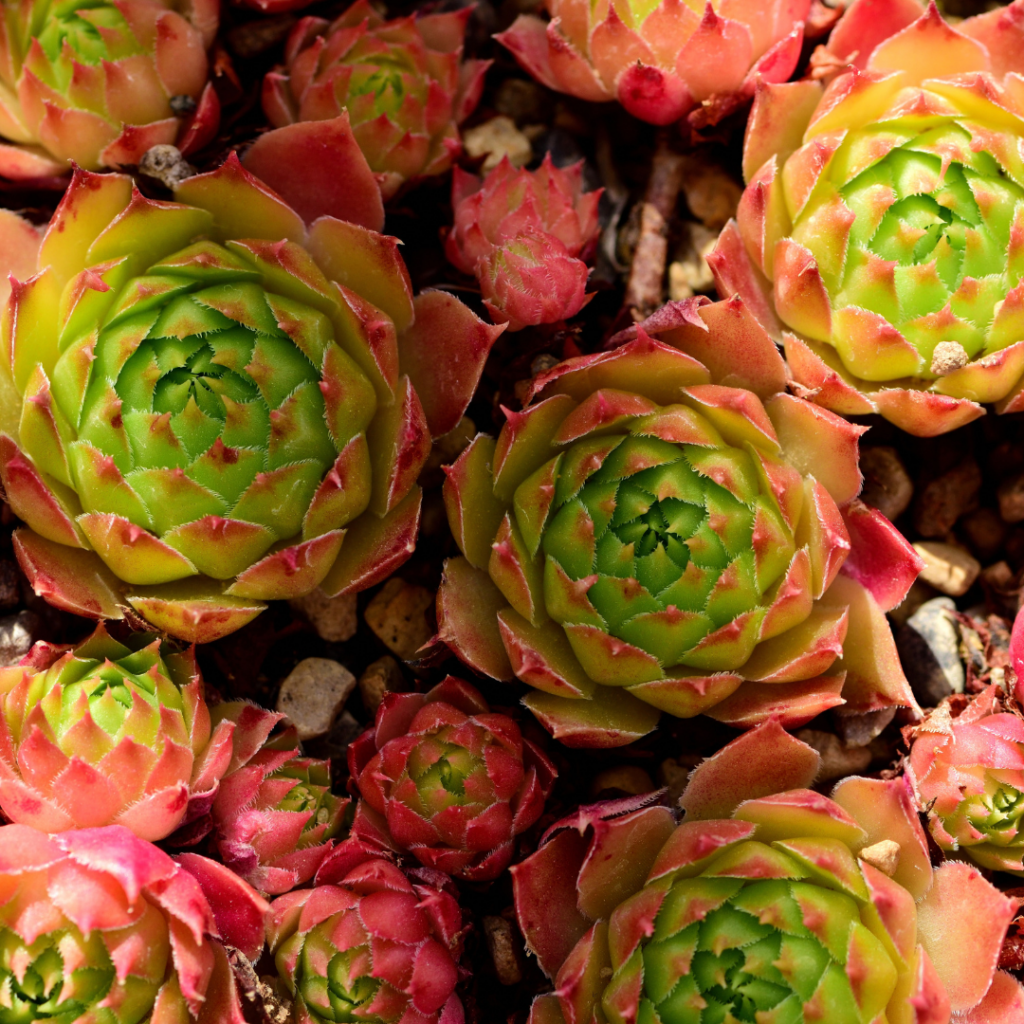
Job’s Beard is a super rare houseplant that forms rosettes of flat rounded leaves with a pointed tip.
Overview
Job’s Beard is a tiny purplish succulent that creates rosettes of thick, fleshy, purple-green leaves, sometimes contrasted with white margins. The rosettes continue to live after blooming, and the plants keep their pretty colors year-round. It can be easily propagated using offsets, leaves, or small cuttings. Furthermore, it is easy to care for and has no significant disease or pest problems. Mealybugs, however, can be a problem sometimes.
Job’s Beard Care Guide
| Care Factor | Requirement for Job\’s Beard |
| Soil | Plant it in well-draining soil with a slightly acidic to neutral pH. Use a mix of potting soil, sand, and perlite for the best results. |
| Light | Full sun to partial shade, preferably at least 6 hours of direct sunlight daily. Avoid exposing the plant to intense midday sun in hot climates. |
| Temperature & Humidity | Tolerates a wide range of temperatures, from -30 °F to 100 °F (-34 °C to 38 °C). Can tolerate low humidity but benefits from occasional misting in hot and dry climates. |
| Watering | Irrigate deeply but infrequently. Allow the soil to dry completely between waterings. Avoid getting water on the leaves to prevent rot. |
| Feeding | Generally does not require regular fertilization. |
| Toxicity | The plant is non-toxic to humans and pets. |
Where To Buy?
Sempervivum heuffelii \’Beaver\’ Succulent Seeds – Etsy
20. Aglaonema (Aglaonema rotundum)
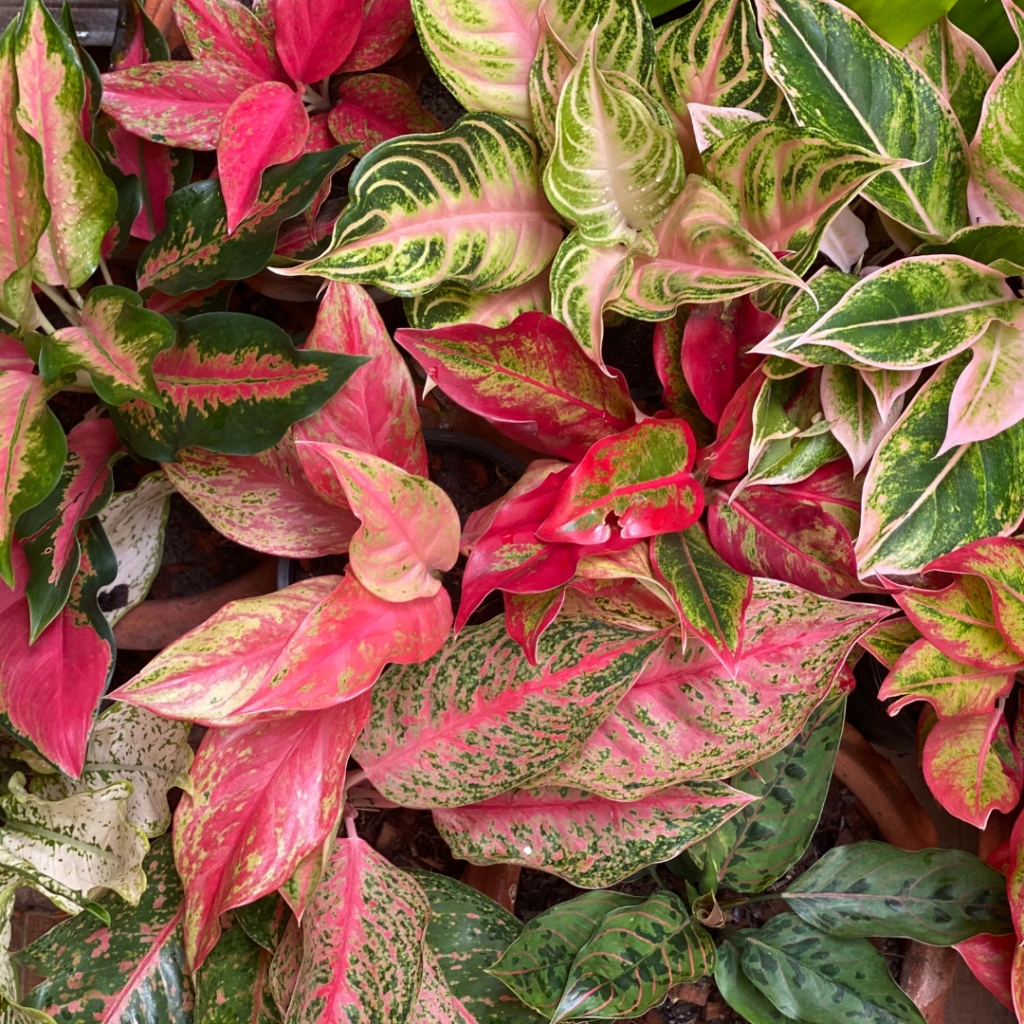
Thanks to its purple hues, Aglaonema is considered one of the most beautiful indoor plants.
Overview
Aglaonemas are often vibrant and colorful, with strikingly patterned leaves. Aside from the spectacular look of these plants, Aglaonema is easygoing, and you can take care of it quickly. Commonly called the ”Chinese Evergreen,” this plant is native to the tropical forest floors of Asia. However, it can be grown in many parts of the United States. For more information on its requirements, see the table below.
Aglaonema Care Guide
| Care Factor | Requirement for Aglaonema |
| Soil | Use well-draining soil with a slightly acidic pH. |
| Light | It can tolerate low to medium indirect light but prefers bright indirect light. Avoid direct sunlight as it can scorch the leaves. |
| Temperature & Humidity | Place indoors at 60 to 75 °F (15 to 24 °C). Use moderate to high humidity levels. Avoid exposing the plant to cold drafts. |
| Watering | Water thoroughly, but allow the soil to dry out between waterings. Reduce watering during the winter. |
| Feeding | Fertilize every 2 to 4 weeks during the growing season Feed with a balanced liquid fertilizer. |
| Toxicity | The plant is toxic if ingested, causing mouth and gastrointestinal irritation. Keep away from pets and children. |
Where To Buy?
Aglaonema Live Indoor cuttings – Etsy
Final Thoughts
Having read this lengthy blog, it should be no surprise that purple indoor houseplants can be a lovely addition to any office, living, and lounge space. You can find them in a wide range of sizes, and they require little care. However, please do your homework and ensure you find the right purple indoor houseplant before bringing one home. With some care, your purple houseplant will grace your home with its stunning blooms for years.
What are your favorite indoor purple plants? Let us know in the comment section below. Also, check out our other plant lists.
20 Fantastic Red Plants (Including Pictures)
21 Beautiful Types Of Yellow Plants (Including Photos)
Giving the Green Light: 11 Different Types Of Dark Green Plants







